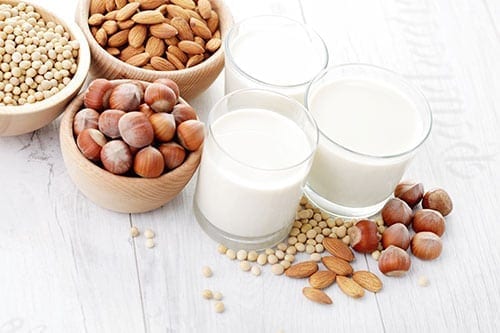Whether you are topping off a bowl of whole grain, unsweetened cereal or simply having a refreshing beverage, the variety of choices being offered as alternatives to cow’s milk is daunting. Your choice should be made based on your daily nutritional requirements, digestive health and what you like best. Remember, all milk choices count as a carbohydrate serving. There is an array of reasons why people are staying away from cow’s milk. Some do not like the milk sugar referred to as lactose. Other wants to stay away from the high content of protein or fat found in whole milk products. There are also people eating vegetable-based diets that do not want to drink milk from an animal. The major concerns for people with diabetes are limiting their daily sugar and reducing fat in their diets.
Which Milk to Choose?
If you send someone to the store to pick up a half gallon of milk, make sure to be specific. Today, there are many choices, including almond, soy, cashew, coconut, Lactaid, or cow’s milk. With all these options, does it really matter which one you choose when you have diabetes.
Cow’s Milk
Despite the lactose, there are still reasons why it is a top choice for many people. It has added vitamin D, calcium and the highest level of protein. For children or people who are involved in sports, it is a good source of amino acids for strong bones and muscles. A glass of milk contains 30 percent of your daily calcium requirements. Whether it is whole, low-fat or skim, it all contains the same level of lactose but the number of calories and fat will vary. Whole milk contains the most calories due to the fat content.
Skim has fewer calories, but still contains the same variety of nutrients including calcium, phosphorus, niacin, riboflavin, protein, potassium, vitamin A, vitamin D and vitamin B12. Those who are lactose-intolerant often choose plant-based alternatives, or Lactaid. Skim milk also contains less fat which will help with weight reduction, a plus when you have diabetes.
Plant-based Milk Alternatives
Plant-based alternatives are becoming popular because they typically have fewer calories and do not raise LDL cholesterol levels. For example, cashew milk contains only 25 calories per 8-ounce glass. It also contains almost half your daily requirement of calcium, vitamin B12 and vitamin E. Keep in mind cashews must be highly processed to be transformed into a beverage. The nutrients are supplemented, which means they do not occur naturally in these high levels.
Other choices have less protein than cow’s milk (unless it is added), and some have more saturated fat. Some plant-based options have added sugar, especially the ones that are flavored or sweetened. Try to stay away from plant-based alternatives with a long ingredient list, as these might include sugars and thickening agents such as carrageenan, which could be associated with gastrointestinal disturbance. The only ingredients usually found in plain milk are vitamin D and the milk itself.
Soy
Soy milk may be a good choice since it has 80 calories per glass, 7 grams of protein and 1 gram of sugar with no saturated fat. It is often fortified with vitamin D and calcium and comes in low and full-fat versions. A recent study in the “Journal of Renal Nutrition” found it improved blood pressure in people with diabetes who had neuropathy. Always shake before you drink, because the added nutrients may sink to the bottom of the container.
Almond
Almond milk contains 30 calories per glass and 1 gram of protein and fiber. The unsweetened type has no sugar and no saturated fat, and has a tasty, nutty flavor. It is free of lactose and cholesterol. Many types are fortified with vitamin D and calcium. If not, you may need to add more protein to your diet.
Coconut
Unsweetened coconut milk has less than 1 gram of sugar, no protein or fiber and 60 calories per glass. It also has 5 grams of saturated fat. Coconut milk is creamy and flavored versions can have up to 450 calories per glass. It is better to choose a lighter version with less fat and calories. Coconut milk also has 25 percent vitamin D and 30 percent calcium.
Lactaid (lactose-free)
When cow’s milk that is not treated with growth hormone (and therefore does not contain lactose), it is called Lactaid. It contains no fat, with 65 percent of the calories coming from carbohydrates and 125 milligrams of sodium. There are 110 calories in a cup of low-fat Lactaid milk. It tastes the same as regular cow’s milk.
Additional Factors
Three factors should be considered when you make a final choice about milk selection.
- If it does not have much protein, you need to add more to your daily diet.
- Select unsweetened dairy milk to avoid blood sugar spikes.
- Read the label on plant-based milk to see if it has been fortified with vitamin D, calcium and other nutrients to make sure you get the right amount.
Final Thoughts
Whether you choose cow’s milk or fortified plant-based alternative, calcium may reduce your risk for high blood pressure. Stay away or limit your intake of flavored milks, like chocolate, that tend to be higher in added sugars. Keep sugar, carbohydrates, fat and taste in mind as you make a final decision. Selecting the right option is sure to be the perfect complement to a couple of sugar-free cookies.
With all the types of milk on the market, always read the label to help you make a good choice. Look for fat, carbohydrate, sugar, sodium and calories to make an educated decision. No matter which one you prefer, make sure it is part of a well-balanced diet that is rich in essential nutrients.







Leave A Comment